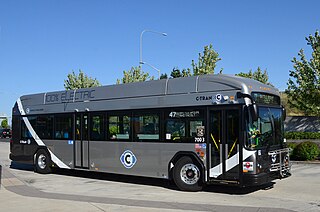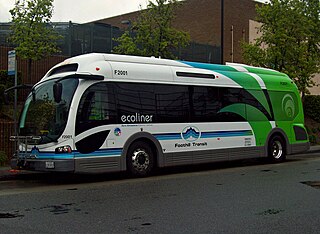
The Toronto Transit Commission (TTC) uses buses and other vehicles for public transportation. In 2018, the TTC bus system had 159 bus routes carrying over 264 million riders over 6,686 kilometres (4,154 mi) of routes with buses travelling 143 million kilometres in the year. As of 2021, the TTC has 192 bus routes in operation, including 28 night bus routes. In 2023, the system had a ridership of 362,041,400, or about 1,179,700 per weekday as of the third quarter of 2024.

Van Hool NV is a Belgian coachbuilder and manufacturer of buses, coaches, trolleybuses, and trailers.

The Orion V was a line of rigid high-floor transit buses available in 32', 35', and 40' lengths manufactured by Ontario Bus Industries between 1989 and 2009. The conventionally powered buses, either with longitudinally mounted diesel or natural gas engines, used a T-drive transmission coupling. The Orion V replaced the Orion I, and was in turn replaced by the low-floor Orion VI and Orion VII.

The Thomas Saf-T-Liner C2 is a bus manufactured by Thomas Built Buses since 2004. The first cowled-chassis bus designed by Thomas following its acquisition by Freightliner, the C2 debuted the first all-new body design for the company in over three decades. Produced primarily as a yellow school bus, the model line is also produced for commercial use and other specialty configurations.

A battery electric bus is an electric bus that is driven by an electric motor and obtains energy from on-board batteries. Many trolleybuses use batteries as an auxiliary or emergency power source.

A charging station, also known as a charge point, chargepoint, or electric vehicle supply equipment (EVSE), is a power supply device that supplies electrical power for recharging plug-in electric vehicles.

A battery electric vehicle (BEV), pure electric vehicle, only-electric vehicle, fully electric vehicle or all-electric vehicle is a type of electric vehicle (EV) that uses electrical energy exclusively from an on-board battery pack to power one or more electric traction motors, on which the vehicle solely relies for propulsion. This definition excludes hybrid electric vehicles, which use internal combustion engines (ICEs) in adjunct to electric motors for propulsion; and fuel cell electric vehicles (FCEVs) and range-extended electric vehicles (REEVs), which consume fuel through a fuel cell or an ICE-driven generator to produce electricity needed for the electric motors. BEVs have no fuel tanks and replenish their energy storage by plugging into a charging station or electrical grid, and use motor controllers to modulate the output engine power and torque, thus eliminating the needed for clutches, transmissions and sophisticated engine cooling as seen in conventional ICE vehicles. BEVs include – but are not limited to – all battery-driven electric cars, buses, trucks, forklifts, motorcycles and scooters, bicycles, skateboards, railcars, boat and personal watercraft, although in common usage the term usually refers specifically to passenger cars.
The lithium-titanate or lithium-titanium-oxide (LTO) battery is a type of rechargeable battery which has the advantage of being faster to charge than other lithium-ion batteries but the disadvantage is a much lower energy density.

The Gillig Low Floor is a transit bus manufactured by Gillig since 1997. The second low-floor bus design introduced in the United States, the Low Floor originally served as a second product range for the company alongside the Gillig Phantom. As transit bus operators shifted toward low-floor designs, the Low Floor has replaced the Phantom entirely, becoming the sole vehicle platform offered by the company since 2008.

The Quad Cities MetroLINK, officially the Rock Island County Metropolitan Mass Transit District, provides mass transportation for the Illinois half of the Quad Cities metro area. Both Iowa cities that make up the region have their own systems, several MetroLINK routes connect with Davenport CitiBus, and Bettendorf Transit. It is the only transit system in the Quad Cities that operates seven days a week. The system has a fleet of 68 fixed route buses that is composed of Twelve 35-foot compressed natural gas buses, Thirty Eight 40-foot compressed natural gas buses As of 2022, they have seventeen all electric buses. Its annual ridership is 3.5 million.

Proterra Inc. was an American electric vehicle and powertrain manufacturer based in Burlingame, California. The company designed and manufactured battery electric transit buses, powertrain systems for other heavy-duty vehicle builders and charging systems for fleets of heavy-duty vehicles.

The BYD K series bus are a line of battery electric buses manufactured by the Chinese automaker BYD, powered with its self-developed lithium iron phosphate battery, featuring a typical operating range of 250 kilometres (160 mi) per charge under urban road conditions. It is available in several different nominal lengths, from 7.0 to 13.7 m and also as a 18 m (60 ft) (articulated) bus. The rear axle is powered by two electric traction motors; the battery capacity and motor power of each model varies depending on the nominal length and passenger capacity.

A solar bus or solar-charged bus is a bus that is powered exclusively or mainly by solar energy. Solar-powered bus service is referred to as a solar bus service. The use of the term "solar bus" normally implies that solar energy is used not only for powering electric equipment on the bus, but also for the propulsion of the vehicle.

The New Flyer Xcelsior is a line of transit buses available in 35-foot rigid, 40-foot rigid, and 60-foot articulated nominal lengths manufactured by New Flyer Industries since 2008. In addition to the different available lengths, the buses are sold with a variety of propulsion systems: conventional diesel, compressed natural gas (CNG), diesel-electric hybrid, hydrogen fuel cell, overhead electric wire and battery electric. A future autonomous bus variant was announced in January 2021.
As of 2019, King County Metro operates the seventh largest fleet of buses in the United States, with a total of 1,583 buses. The agency's buses traveled a total of 53 million miles (85,000,000 km) and transported over 123 million passengers in 2019.

The Proterra Catalyst is a battery-electric low-floor transit bus that was built by Proterra from 2014 to 2020. The second generation of Proterra's battery-electric buses, it succeeded the earlier EcoRide as the company's flagship product.

SAE J3105 is a recommended practice for automated connection devices (ACD) that mate chargers with battery electric buses and heavy-duty vehicles. The practice is maintained by the SAE International with the formal title "Electric Vehicle Power Transfer System Using Conductive Automated Connection Devices Recommended Practice", and was first issued in January 2020. It covers the general physical, electrical, functional, testing, and performance requirements for automated conductive DC power transfer systems intended for heavy duty vehicles, focusing primarily on transit buses.

The Proterra EcoRide BE35 is a 35 foot (11 m) fast-charge battery electric bus that seats 38 with a total passenger capacity of 60 in its composite low floor body. Foothill Transit was the first transit agency to operate the buses in revenue service, starting in September 2010. It is the first 30 ft (9 m) or larger, heavy-duty all-electric bus ever to complete federally required durability, reliability and safety testing at the Bus Research and Testing Center in Altoona, Pennsylvania. The 12yr/500,000 miles (800,000 km) STURAA test was completed on March 5, 2012.

The ENC Axess is a line of low-floor transit buses available in 35-foot and 40-foot nominal lengths manufactured by ENC in Riverside, California starting from 2003. In addition to the different available lengths, the buses are sold with a variety of prime movers, ranging from conventional diesel, LNG/CNG combustion engines, diesel-electric hybrid and hydrogen fuel cell with a traction motor.



















